Hurricane Creek Mine Disaster Memorial
Introduction
Author-Uploaded Audio
Audio by Holley Snaith
Text-to-speech Audio
Images
The Hurricane Creek Mine Disaster Memorial in Hyden, Kentucky
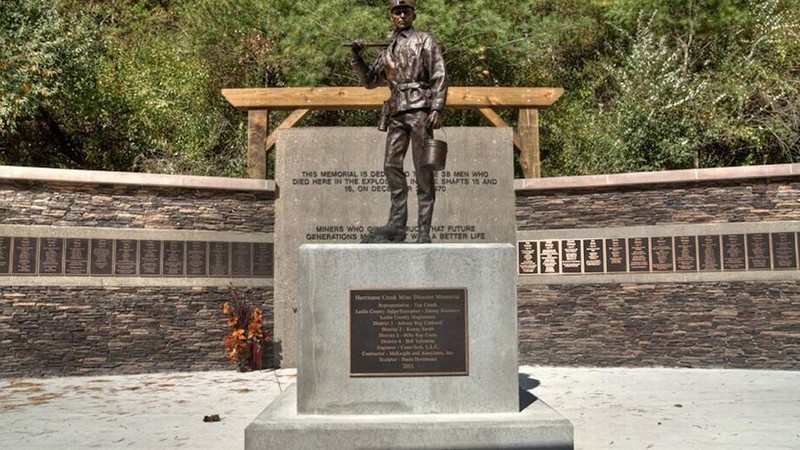
Honoring the 38 Men Who Died in the Finley Mine Explosion
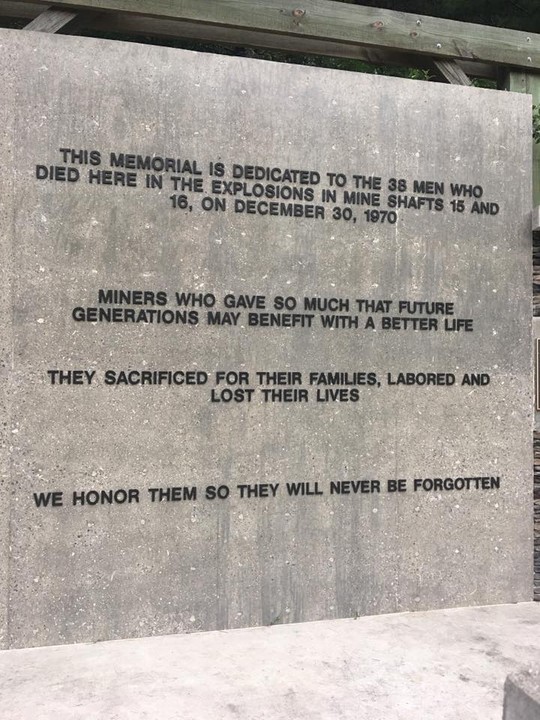
Hurricane Creek Mine Disaster Historical Marker
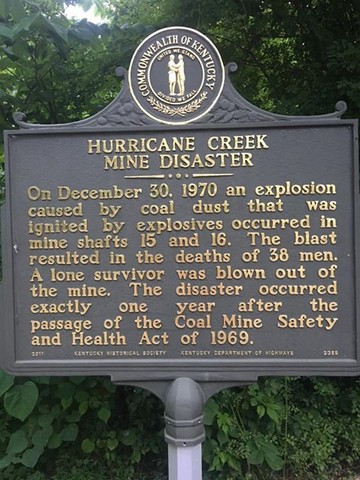
The Names of the Miners Who Died Line the Memorial
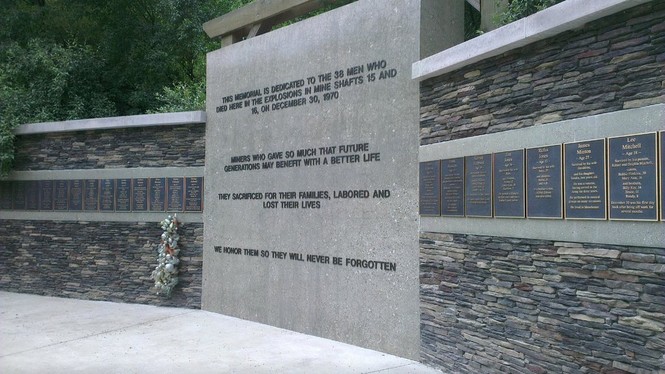
A Miner Shoveling Coal
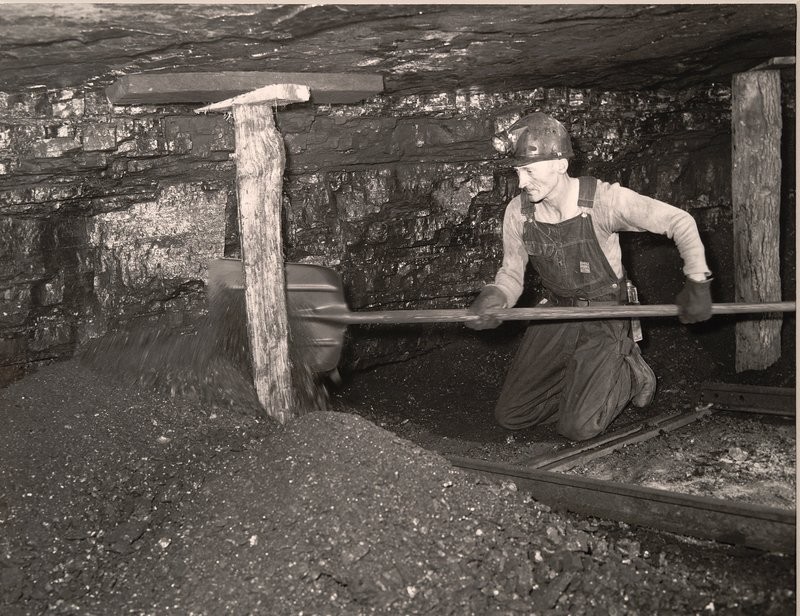
Backstory and Context
Author-Uploaded Audio
Audio by Holley Snaith
Text-to-speech Audio
The early morning of December 30, 1970 was a cold blustery one when around forty coal miners entered the Finley Coal Co. Nos. 15 and 16 Mines, located on Hurricane Creek in Hyden, Kentucky. Just a few short hours later, just after noon time, an explosion ripped through the mine that people miles away could hear and feel. The cause of the explosion was the result of a primer cord that ignited coal dust. One man, A.T. Collins, who was the conveyor belt operator, was thrown nearly sixty feet outside the mine into the road. Thirty-eight other men were not as lucky, they all perished in the explosion.
As the cold winter day went on, victims were slowly pulled out of the mine and taken by ambulance to the local school's gymnasium where their loved ones came to identify the bodies. Some of the men had been so badly shattered by the coal dust explosion that the only way to identify them was by their Social Security number, worn on the back of their belts. The ages of the miners ranged from 18 to 60. The disaster was one of the most deadly mining disasters in American history, and the worst in Eastern Kentucky. Just one year prior to the Hurricane Creek Mine Disaster, President Richard Nixon had signed the Federal Coal Mine Health and Safety Act into law, establishing new safety measures that would prevent such disasters. After finding traces of dynamite and Primacord (a brand of detonating cord) in the mine, which were both banned by the law, an investigation concluded that there was "nearly absolute failure" in enacting the law.
In response to the mining disaster, the second one in a three year span, the U.S. Bureau of Mines director Elburt Osborn callously remarked, "This disaster was not unexpected. We've had two good years since Farmington (in West Virginia, where 78 miners were killed) and I think we can expect almost one of these a year." After Hurricane Creek, no new mine-safety regulation was passed at the state or federal level. Even the owner, Charles Finley, went on trial for negligent operation but in the end paid no penalty.
Upon hearing of the deaths of the thirty-eight men and of the 104 children in total they left behind, country music singer Loretta Lynn organized a big benefit to aid the widows and their children. Lynn, who had just released her hit song "Coal Miner's Daughter," grew up just seventy-five miles from Hyden and was aware that Leslie County was one of the poorest in the nation. The benefit took place on March 1, 1971 in Freedom Hall in Louisville, with close to 15,000 people in attendance. More than forty country music performers joined Loretta Lynn for the benefit and Colonel Sanders provided free dinners. Later in 1971, singer and songwriter Tom T. Hall would record a song called "Trip to Hyden," discussing his own personal journey to the sad town and the effects of the disaster.
For decades after the disaster occurred, all that stood on the site was a large pile of dirt. It appeared the story of the miners' fate would eventually fade into history. But almost forty years after the Hurricane Creek Mine disaster, A.T. Collins' son started a movement to build a memorial to all the men using coal severance money. In 2011, the Hurricane Creek Mine Disaster Memorial was dedicated, featuring plaques with all of the names of those who died, and the one who survived, as well as those they left behind.
Sources
Potter, Leslie. Hurricane Creek Mine Disaster Memorial, KET. October 20th 2019. Accessed February 17th 2020. https://www.ket.org/living/hurricane-creek-mine-disaster-memorial/.
Hurricane Creek Mine Memorial, Trails of Leslie County. Accessed February 17th 2020. http://trailsoflesliecounty.org/local-attractions/hurricane-creek-mine-memorial/.
Oppegard, Tony. 45 years ago, 38 miners were sacrificed for coal, Lexington Herald Leader. December 29th 2015. Accessed February 18th 2020. https://www.kentucky.com/opinion/op-ed/article52137230.html.
In Memory of the 1970 Finley Coal Mine Disaster, Facebook. December 30th 2019. Accessed February 18th 2020. https://www.facebook.com/pg/In-Memory-of-the-1970-Finley-Coal-Mine-Disaster-107344462639601/posts/.
Vecsey, George. All Bodies Recovered, The New York Times. January 1st 1971. Accessed February 18th 2020. https://www.nytimes.com/1971/01/01/archives/all-bodies-recovered-all-bodies-found-in-mine-disaster.html.
Lynn, Loretta. Coal Miner's Daughter, Regnery-Geis. May 1st 1976. Accessed February 18th 2020.
Lexington Herald Leader
Trails of Leslie County
Trails of Leslie County
Mine Disasters in the United States
University of Kentucky
